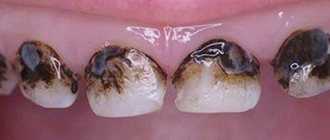21.11.2019
A filled tooth may not bother a person for a long time, not change its appearance and not show any signs of destruction. However, fillings do not always last for many years and protect teeth from pathological changes. The first sign of destructive processes is darkening of the enamel. What to do if a tooth under a filling turns black? What are the reasons for this phenomenon, and what steps should be taken to avoid losing the tooth altogether?
Additional symptoms
Typically, the appearance of secondary caries is accompanied not only by darkening, but also by a number of other symptoms that are difficult to miss. What should you pay attention to if your teeth turn black? Let's consider additional symptoms:
- change in enamel color, appearance of a black dot on the surface, darkening and other visual signs of destruction;
- bad breath, especially in the morning after waking up, is the result of the development of pathogens and tissue destruction;
- mobility of the filling, which may eventually partially crumble or fall out completely;
- pain, especially if the nerves are not removed;
- redness of the gums caused by the presence of an inflammatory process.
Even if the blackening of the filling is not accompanied by the additional symptoms described above, it is recommended to undergo a preventive examination so that a specialist can identify the causes of the problem and determine the tactics for further action.
Who is susceptible to changes in the shade of the filling?
Unfortunately, some patients experience darkening of their fillings more often than others. There may be several explanations for this. The most common factors include, of course, smoking and poor oral hygiene. It is important to understand that teeth need to be cleaned of plaque not only in the morning and evening, but also after every meal.
The filling can also be affected by existing caries underneath or around it. If the professional does not completely clean the affected areas of the tooth, tooth decay can continue to destroy the tooth from the inside. Also, the filling may become stained due to frequent consumption of black tea, strong coffee, natural juices and red wine.
To prevent darkening, it is recommended to reduce the frequency of smoking and avoid foods and drinks that contain bright dyes. Also, do not neglect preventive examinations at the dental clinic, where you can periodically clean the oral cavity using any of the modern methods.
Diagnostics
The task of diagnosis is to determine why the filling material and the dental elements underneath have turned black. Professional techniques will help identify the presence of caries and the extent of damage in order to make a final decision on removal or treatment.
Diagnosis consists of a visual examination, as well as an x-ray examination. If concomitant diseases of the oral cavity are suspected, additional diagnostic methods can be used.
Myths and legends about “black” fillings
It so happened historically that amalgam as a filling material did not take root very well in countries where there is no health insurance system: either due to the mercury content, or because of complex hygienic requirements (hood, separate room), or simply because for unaesthetic appearance: - not everyone from the outside can distinguish an amalgam filling from caries.So why do we sometimes hear from a doctor about this method? The fact is that only treatment with such material is paid to doctors in the Czech Republic by the insurance company. Moreover, this refers to the most prehistoric method of making amalgam: pour in silver, pour in mercury, mix and quickly apply it to the tooth before it hardens. And this all happens in the room where we treat the patient. The alternative type of amalgam fillings (in capsules, dosed) is not covered by compulsory health insurance, that is, the patient must pay for it. Would anyone want to receive such beauty for their own money? Personally, I don't.
Are amalgam fillings harmful? If it is mixed correctly, then it causes harm only to the doctor during its manufacture (yes, we breathe mercury in the dental office!) and during the removal of a filling when re-treating a tooth (here the patient is already breathing mercury, who accidentally swallow). And, of course, the environment suffers: the issue of amalgam disposal has not been fully resolved.
It is for a number of these reasons that amalgam is a prohibited material in a number of developed countries: Sweden, Denmark, Japan... In Germany, it is prohibited to place amalgam fillings on children and pregnant women.
But even if we put aside all the controversy regarding the harm of amalgam fillings, many questions still remain: is amalgam worse than other materials? Is it necessary to change “black” fillings to “white” ones? What to choose at a doctor’s appointment: a free filling or a paid one? There is no clear answer...
In my private practice, in most cases I have to recommend getting rid of amalgam fillings. There are a number of reasons for this. Here are just a few of them:
- caries under a “black” filling. As a rule, the doctor, when making a filling under insurance, is guided by time restrictions within six to fifteen minutes. Based on personal experience and the experience of colleagues, I can say that the average duration of caries treatment is at least 45 minutes (subject to all requirements and recommendations). It becomes clear that no matter how hard the doctor tries to completely remove caries and make the filling as high as possible, it is not possible to do this.
- new caries around the amalgam. The completion of the chemical hardening reaction lasts from six to 24 hours. Only after this can you safely polish such a filling. But not every doctor will book a patient in the next day just to polish a filling. Thus, the patient almost always leaves the office with an unpolished filling and lives with it for a long time. This leads to the accumulation of plaque around the filling, food retention and, as a result, new caries around the filling.
- aesthetics . Not everyone wants to show black spots with a wide smile.
But there are also exceptions. In some cases, I personally persuade the patient not to change the “black” filling. The reasons may be the following: absence of caries during visual and x-ray (required!) inspection of the tooth; absence of tooth cracks around the amalgam (amalgam, due to expansion during hardening and chewing stress, can lead to cracks and splitting of the tooth).
It must be remembered that not every “black” filling is worse than a “white” one. White fillings are very demanding in terms of manufacturing conditions. Therefore, the time spent on making a composite filling is many times greater than on making an amalgam filling according to insurance company standards. But with the right approach to the dental treatment process, photocomposite fillings can serve without problems for years and decades.
As for me and our private practice, when asked by a patient how long my treatment will last, I always answer: “I hope it will last a lifetime.”
Dentist Mikhail Kosteniuk
Dental center DENTA, tel. 725 375 555
Chomutovická 1444/2, Praha 4, metro Opatov
Therapy
If the filling on the front tooth or on any other tooth has darkened, there are three possible solutions to the problem, the choice of which should be determined by the diagnostic results:
- Removal: performed if the tooth is so damaged that it cannot be cured;
- Removing an old filling, treating caries and installing a new filling material;
- Installation of a dental crown after complete elimination of the pathology.
If complications develop and other diseases occur, additional therapeutic measures may be required to eliminate the source of infection and restore the tooth.
Features in the use of materials
It happens that the tooth turns black under the filling due to the fact that low-quality material was used. This can give the crown a brown and black tint. This kind of defect is not easy to fix. Especially when the patient visited another clinic and the therapy was carried out a long time ago. The service life of good composite overlays is at least seven years. But it happens that during treatment the root canal was not completely filled. This causes the problem to appear quickly.
Outdated filling cements can distort light refraction and also become dark from light. In such a situation, pathogenic bacteria actively multiply in the microscopic cavities of the units. This is facilitated by small particles of food that accumulate in the voids. Decay products collect in the dentinal tubules. All this causes a change in the color of the crowns. Even with light enamel, the color of the crowns can change, since the yellowness of the dentin is visible through the transparent layer of enamel.
Today, laser dental treatment is widely used, after which there are no defects. What problems does this technology solve?
- Sterilization of cavities from caries.
- Disinfection of root canals.
- Excision of the pathological “hood”.
- Sterilization of pockets for periodontitis.
- Removing infections and opening abscesses.
- Gum plastic surgery.
Prevention
You can prevent blackening of a tooth under a filling with the help of effective prophylaxis. To avoid the need for re-treatment, you should follow several rules:
Firstly, follow all the hygiene instructions of doctors - brush your teeth in a timely and regular manner, using the right toothpaste, floss, and rinses. Secondly, undergo preventive examinations in a timely manner in order to identify and treat any diseases in the early stages, before complications arise.
Try to avoid temperature changes - do not eat hot and cold food at the same time, do not drink hot drinks in the cold. Avoid traumatic effects - do not gnaw hard food (nuts, seeds) with filled teeth. Treat any infectious diseases in a timely manner, including those that are not directly related to the oral cavity.
Get rid of bad habits that disrupt the body’s activities and weaken its protective functions. Do not skimp on tooth restoration and, if the filling has darkened, replace it in a timely manner.
Uniform darkening
If after a few days or weeks you suddenly see that the installed filling has evenly changed its color and has become, for example, pink or yellow, this most likely indicates a violation of your dentist’s instructions. Perhaps you did not listen to the advice of a specialist and ate some coloring vegetable or drank strong coffee without milk.
To eliminate this defect, be sure to seek help from your doctor. He will be able to polish the composite material and perform a high-quality cleaning, as a result of which the filling will again become its original color. After this, you will not be able to eat food containing dyes for some time. Otherwise, all the efforts of the master will be in vain.
Old fillings are also susceptible to staining. This may be due to the fact that the patient exposes them to too sudden temperature changes, that is, he may eat ice cream and drink hot tea at the same time. All this leads to changes in the volume of the filling: it can imperceptibly narrow and expand. As a result, microbes and food particles penetrate into the small cracks and cracks that form. This filling can either be replaced or polished.
Treatment after diagnosis
Once the diagnosis is made, treatment begins. It depends on how much caries has developed again. Secondary caries can occur on the chewing surface, and if the lesion is small, the entire filling may not be removed. It is enough to clean only the affected area and drill out the filling a little, then seal the cleaned area with the same material.
If the entire tooth is destroyed and caries penetrates deep into the roots, the filling will have to be completely removed. Actually, the treatment continues according to the usual traditional scheme. First, the doctor cleans out the damaged tooth tissue. If the caries has reached the nerves, they will also have to be removed (here you will have to be patient, otherwise neither the patient nor the tooth may be able to withstand the third attempt to cure the tooth).
After this most painful procedure, you need to treat the drilled cavity with an antiseptic to make it sterile for sure. After this, fill the tooth and polish the surface of the filling so that frequent friction due to the uneven surface will deteriorate it and not break prematurely.
Sometimes, if the caries under the filling is deep and has reached the roots, sometimes the treatment is delayed for several visits to the doctor, but usually no more than two. Those who have a tendency to develop caries should be very careful about preventive measures and dental and oral hygiene.











